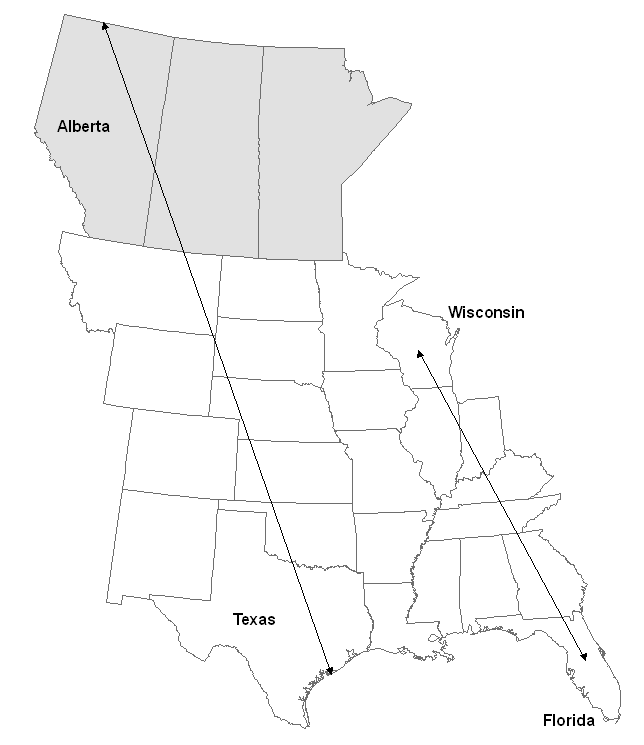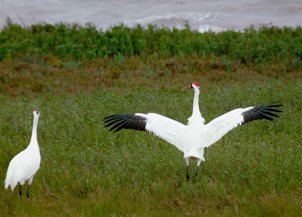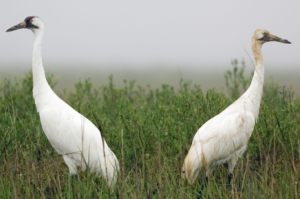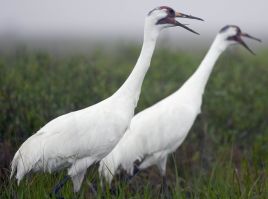Whooping Crane (Grus americana)
- Texas Status
- Endangered
- U.S. Status
- Endangered, Listed 6/02/1970
- Description
At nearly 5 feet (1.5 m) tall, whooping cranes are the tallest birds in North America. They have a wingspan of 7.5 feet (2.3 m). Whooping cranes are white with rust-colored patches on top and back of head, lack feathers on both sides of the head, yellow eyes, and long, black legs and bills. Their primary wing feathers are black but are visible only in flight.
- Life History
The tallest bird in North America, the whooping crane breeds in the wetlands of Wood Buffalo National Park in northern Canada and spends the winter on the Texas coast at Aransas National Wildlife Refuge near Rockport. Whooping cranes begin their fall migration south to Texas in mid-September and begin the spring migration north to Canada in late March or early April. Whooping cranes migrate more than 2,400 miles a year. As many as 1,400 whooping cranes migrated across North America in the mid-1800s. By the late 1930s, the Aransas population was down to just 18 birds. Because of well-coordinated efforts to protect habitat and the birds themselves, the population is slowly increasing. In 1993, the population stood at 112. In the spring of 2002, it is estimated that there were 173 whoopers - a small, but important increase. Today, three populations exist: one in the Kissimmee Prairie of Florida, the only migratory population at Aransas National Wildlife Refuge, and a very small captive-bred population in Wisconsin.
Whooping cranes mate for life, but will accept a new mate if one dies. These long-lived birds cranes can live up to 24 years in the wild. The mated pair shares brooding duties; either the male or the female is always on the nest. Generally, one chick survives. It can leave the nest while quite young, but is still protected and fed by its parents. Chicks are rust-colored when they hatch; at about four months, chicks' feathers begin turning white. By the end of their first migration, they are brown and white, and as they enter their first spring, their plumage is white with black wing tips.
The hatchlings will stay with their parents throughout their first winter, and separate when the spring migration begins. The sub-adults form groups and travel together. Cranes live in family groups made up of the parents and 1 or 2 offspring. In the spring, whooping cranes perform courtship displays (loud calling, wing flapping, leaps in the air) as they get ready to migrate to their breeding grounds. Their diet consists of blue crabs, clams, frogs, minnows, rodents, small birds, and berries. Early 1999 counts showed 183 birds left the wintering grounds on the Texas coast (with smaller populations in New Mexico and Florida).
- Habitat
Whooping cranes winter on the Aransas National Wildlife Refuge's 22,500 acres of salt flats and marshes. The area's coastal prairie rolls gently here and is dotted with swales and ponds. They summer and nest in poorly drained wetlands in Canada's Northwest Territories at Wood Buffalo National Park.
- Distribution

Although they breed in Canada during the summer months, whooping cranes migrate to Texas' coastal plains near Rockport, in and around Aransas National Wildlife Refuge, from November through March.
How you can help:
Whooping cranes migrate throughout the central portion of the state from the eastern panhandle to the DFW area and south through the Austin area to the central coast during October-November and again in April. For information about reporting a sighting, visit the Texas Nature Trackers: Texas Whooper Watch page.
- Other
Whooping cranes are one of the rarest bird species in North America. Whooping cranes are protected in Canada, the United States and Mexico. Because some of their habitat is federally protected, the land is managed to preserve the animals. The greatest threats to whooping cranes are man-made: power lines, illegal hunting, and habitat loss. Because the Gulf International Waterway goes through their habitat area, the cranes are susceptible to chemical spills and other petroleum-related contamination. Public awareness and support are critical to whooping cranes' survival as a species.


